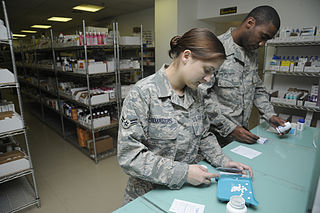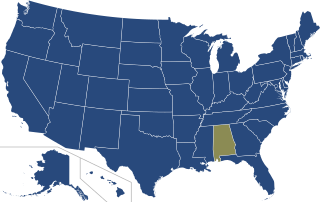Related Research Articles

A pharmacist, also known as a chemist or a druggist, is a healthcare professional who dispenses medications and who provides advice on their effective use, with the aim of preventing disease and promoting public health. Pharmacists often serve as primary care providers in the community, and may offer other services such as health screenings and immunizations.

Pharmacy is the science and practice of discovering, producing, preparing, dispensing, reviewing and monitoring medications, aiming to ensure the safe, effective, and affordable use of medicines. It is a miscellaneous science as it links health sciences with pharmaceutical sciences and natural sciences. The professional practice is becoming more clinically oriented as most of the drugs are now manufactured by pharmaceutical industries. Based on the setting, pharmacy practice is either classified as community or institutional pharmacy. Providing direct patient care in the community of institutional pharmacies is considered clinical pharmacy.

A pharmacy technician performs pharmacy-related functions. Training, certification, licensing, and actual practice of pharmacy technicians varies not only worldwide but in some countries regionally as well as by employer.
The Pharmaceutical Society of Australia (PSA) is a professional organisation of Australian pharmacists. PSA is the peak national body for pharmacists, representing all of the pharmacy profession in Australia, with approximately 18,000 members. PSA is the major provider of continuing professional development programmes for pharmacists in Australia. PSA also organises various pharmacy events including a national conference attended by over 1,200 delegates from around Australia and internationally. PSA publishes the Australian Pharmaceutical Formulary, the Australian Pharmacist journal, and various other pharmacy publications.
American Society of Health-System Pharmacists (ASHP) is a professional organization that represents pharmacists who serve as patient care providers in hospitals, health systems, ambulatory clinics, and other healthcare settings. The organization's nearly 58,000 members include pharmacists, student pharmacists, and pharmacy technicians. ASHP maintains a national database on U.S. drug shortages that is published on their website.

In the field of pharmacy, compounding is preparation of a custom formulation of a medication to fit a unique need of a patient that cannot be met with commercially available products. This may be done for medical reasons, such as administration in a different format, to avoid a non-active ingredient the patient is allergic to, or to provide an exact dose that isn't commercially available. Medically necessary compounding is referred to as "traditional" compounding. It may also be done for medically optional reasons, such as preference of flavor or texture, or dietary restrictions.

The American Pharmacists Association, founded in 1852, is the first-established professional society of pharmacists in the United States. The association consists of more than 62,000 practicing pharmacists, pharmaceutical scientists, student pharmacists, pharmacy technicians, and others interested in the profession. Nearly all U.S. pharmacy specialty organizations were originally a section or part of this association.

Clinical pharmacy is the branch of pharmacy in which clinical pharmacists provide direct patient care that optimizes the use of medication and promotes health, wellness, and disease prevention. Clinical pharmacists care for patients in all health care settings but the clinical pharmacy movement initially began inside hospitals and clinics. Clinical pharmacists often work in collaboration with physicians, physician assistants, nurse practitioners, and other healthcare professionals. Clinical pharmacists can enter into a formal collaborative practice agreement with another healthcare provider, generally one or more physicians, that allows pharmacists to prescribe medications and order laboratory tests.
Over-the-counter counseling refers to the counseling that a pharmacist may provide on the subject of initiating, modifying, or stopping an over-the-counter (OTC) drug product. OTC counseling requires an assessment of the patient's self-care concerns and drug-related needs. The types of drugs that are involved in OTC counseling are, for example, used to treat self-diagnosable conditions like heartburn, cough, and rashes, though prescription drugs and professional diagnoses are also relevant to the recommendation process.
The basic requirement for pharmacists to be considered for registration is often an undergraduate or postgraduate pharmacy degree from a recognized university. In many countries, this involves a four- or five-year course to attain a bachelor of pharmacy or master of pharmacy degree.

A pharmacy is a retail shop which provides pharmaceutical drugs, among other products. At the pharmacy, a pharmacist oversees the fulfillment of medical prescriptions and is available to counsel patients about prescription and over-the-counter drugs or about health problems and wellness issues. A typical pharmacy would be in the commercial area of a community.
The Ohio Automated Rx Reporting System (OARRS) is Ohio's state Prescription Monitoring Program (PMP) and is controlled by the Ohio State Board of Pharmacy. The law permitting the Board of Pharmacy to create the PMP was signed on March 18, 2005, and became effective January 1, 2006. The OARRS program began operation on October 2, 2006. The law is available to read in the Drug Laws of Ohio pages C-50 through C-54. The Ohio State Board of Pharmacy is responsible for collecting and verifying data for prescriptions that the Drug Enforcement Administration (DEA) classifies Schedule II-V as well as carisoprodol and tramadol prescriptions.
There are approximately 88,000 pharmacies in the United States. Over half are located within drug stores, grocery stores, hospitals, department stores, medical clinics, surgery clinics, universities, nursing homes, prisons, and other facilities. The remaining pharmacies are considered to be independent or privately owned. The top 25 pharmacy chain stores represent about 38,000 pharmacy locations in the U.S. and employ about 149,000 on-staff pharmacists. California has 8,015 pharmacies, the most of any state. Texas, Florida, New York, and Pennsylvania round out the top five states for pharmacy locations. Nationwide, the number of community pharmacies increased by 6.3% between 2007-2015, and the number of pharmacies per 10,000 people (2.11) did not change. However, the number of pharmacies per-capita varies substantially across counties, ranging from 0 to 13.6 per- 10,000 people in 2015.
The Pharmacy and Poisons Board is the Drug Regulatory Authority established under the Pharmacy and Poisons Act, Chapter 244 of the Laws of Kenya.
The General Pharmaceutical Council (GPhC) is the body responsible for the independent regulation of the pharmacy profession within England, Scotland and Wales, responsible for the regulation of pharmacists, pharmacy technicians and pharmacy premises. It was created, along with the Royal Pharmaceutical Society, in September 2010 when the previous body responsible for regulation, the Royal Pharmaceutical Society of Great Britain, was split so that representative and regulatory functions of the pharmacy profession could be separated.
Healthcare professional credentials are credentials awarded to many healthcare practitioners as a way to standardize the level of education and ability to provide care.

Telepharmacy is the delivery of pharmaceutical care via telecommunications to patients in locations where they may not have direct contact with a pharmacist. It is an instance of the wider phenomenon of telemedicine, as implemented in the field of pharmacy. Telepharmacy services include drug therapy monitoring, patient counseling, prior authorization and refill authorization for prescription drugs, and monitoring of formulary compliance with the aid of teleconferencing or videoconferencing. Remote dispensing of medications by automated packaging and labeling systems can also be thought of as an instance of telepharmacy. Telepharmacy services can be delivered at retail pharmacy sites or through hospitals, nursing homes, or other medical care facilities.
The American Association of Psychiatric Pharmacists (AAPP) is a professional organization representing pharmacists and other health care professionals in the specialized areas of psychiatric and neurologic pharmacy practice within the United States.

A collaborative practice agreement (CPA) is a legal document in the United States that establishes a legal relationship between clinical pharmacists and collaborating physicians that allows for pharmacists to participate in collaborative drug therapy management (CDTM).

The Joint Commission of Pharmacy Practitioners (JCPP) is the largest professional delegation representing the interests of pharmacists within the United States. JCPP represents 13 professional associations in the field of pharmacy, developing consensus policy directives for the profession. It is well known for the 2014 development of "The Pharmacists’ Patient Care Process," which provides broad, consensus guidelines for how clinical pharmacists should practice.
References
- 1 2 3 Malacos, Kristy. "Pharmacy Technician Regulation". Pharmacy Times. Pharmacy & Healthcare Communications, LLC. Retrieved 1 July 2018.
- ↑ "Pharmacists, Pharmacy Business, and Pharmaceuticals Practice Act" (PDF). Colorado Department of Regulatory Agencies. State of Colorado. p. 36. Retrieved 23 May 2022.
12-280-122. Limited authority to delegate activities constituting practice of pharmacy to pharmacy interns or pharmacy technicians. (1) A pharmacist may supervise up to six persons who are either pharmacy interns or pharmacy technicians, of whom no more than two may be pharmacy interns. If three or more pharmacy technicians are on duty, the majority must be certified by the board in accordance with section 12-280-115.5 (2), and any pharmacy technician on duty who is not certified pursuant to section 12-280-115.5 (2) must have a provisional certification issued pursuant to section 12-280-115.5 (3).
- ↑ "Pharmacy Technician FAQs". Georgia Board of Pharmacy. State of Georgia. Retrieved 23 May 2022.
A5. The pharmacist to pharmacy technician ratio may not exceed one pharmacist providing direct supervision of three pharmacy technicians, and one of the three technicians must be certified. See O.C.G.A. §26-4-82(d). However, upon application and approval by the Board, the pharmacist to pharmacy technician may exceed one pharmacist providing direct supervision to three pharmacy technicians in a hospital setting. See O.C.G.A. §26-4-82(d).
- ↑ "ARC 4291C - Iowa Administrative Rules". State of Iowa’s Administrative Rules. State of Iowa. Retrieved 23 May 2022.
40.3(6) Pharmacist-to-technician ratio. In any pharmacy which utilizes a TPV program, the ratio of pharmacists to technicians physically present in the pharmacy shall not exceed 1:2 at any time, including when TPV is not in use.
- ↑ "NCBOP -Pharmacist FAQs". North Carolina Board of Pharmacy. Retrieved 23 May 2022.
A pharmacist may not supervise more than two pharmacy technicians unless: (1) the pharmacist-manager receives written approval from the Board in advance; and (2) each additional technician is certified. (See G.S. § 90-85.15A.)
- ↑ "Rules of the Tennessee Board of Pharmacy CHAPTER 1140-02 PROFESSIONAL CONDUCT AND RESPONSIBILITIES" (PDF). Tennessee Secretary of State Official Compilation of Rules and Regulations. p. 4. Retrieved 23 May 2022.
The pharmacy technician to pharmacist ratio shall not exceed 2:1; however the ratio may be increased up to a maximum of 4:1 by the pharmacist in charge based upon public safety considerations but only if the additional pharmacy technicians are certified pharmacy technicians. However, the pharmacist in charge may request a modification of the ratio from the Board.
- 1 2 Koehler, T; Brown, A (2017). "A global picture of pharmacy technician and other pharmacy support workforce cadres". Res Social Adm Pharm. 13 (2): 271–279. doi:10.1016/j.sapharm.2016.12.004. PMC 5317197 . PMID 28190479.
- 1 2 Lutz, Rachel. "Pharmacist-Technician Ratios Require More Evaluation". Pharmacy Times. Pharmacy & Healthcare Communications, LLC. Retrieved 1 July 2018.
- ↑ Guglielmo, B. Joseph. "Health care: The pharmacist-to-technician ratio". Capitol Weekly. Capitol Weekly. Retrieved 1 July 2018.
- ↑ Marotta, Ryan. "The Evolving Role of Pharmacy Technicians". Pharmacy Times. Pharmacy & Healthcare Communications, LLC. Retrieved 1 July 2018.